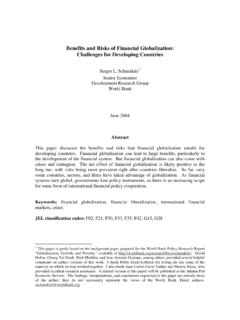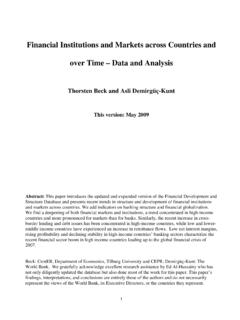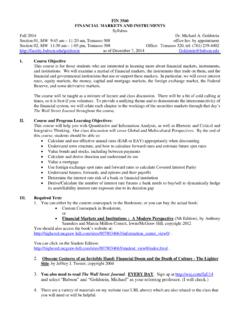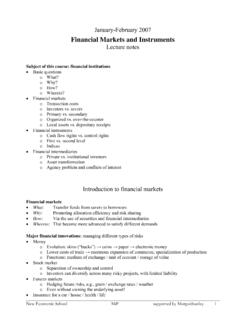Transcription of Financial markets and institutions of the financial market ...
1 1 Financial markets and institutions of the Financial market Financial markets Businesses, individuals, and governments often need to raise capital. On the other hand, some individuals and firms have incomes that are greater than their current expenditures, so they have funds available to invest. TYPES OF markets People and organizations wanting to borrow money are brought together with those having surplus funds in the Financial markets . Note that markets is plural there are a great many different Financial markets in a developed economy such as ours. Each market deals with a somewhat different type of instrument in terms of the instrument s maturity and the assets backing it. Also, different markets serve different types of customers, or operate in different parts of the country.
2 For these reasons it is often useful to classify markets along various dimensions: 1. Physical asset vs. Financial asset markets . Physical asset markets (also called tangible or real asset markets ) are those for such products as wheat, autos, real estate, computers, and machinery. Financial asset markets , on the other hand, deal with stocks, bonds, notes, mortgages, and other claims on real assets, as well as with derivative securities whose values are derived from changes in the prices of other assets. 2. Spot vs. Futures markets . Spot markets are markets in which assets are bought or sold for on-the-spot delivery (literally, within a few days). Futures markets are markets in which participants agree today to buy or sell an asset at some future date. For example, a farmer may enter into a futures contract in which he agrees today to sell 5,000 bushels of soybeans six months from now at a price of $5 a bushel.
3 In contrast, an international food producer looking to buy soybeans in the future may enter into a futures contract in which it agrees to buy soybeans three months from now. 3. Money vs. Capital markets . Money markets are the markets for shortterm, highly liquid debt securities. The New York and London Money markets have long been the world s largest, but Tokyo is rising rapidly. Capital markets are the markets for intermediate- or long-term debt and corporate stocks. The New York Stock Exchange, where the stocks of the largest corporations are traded, is a prime example of a capital market . There is no hard and fast rule on this, but when describing debt markets , short term generally means less than one year, intermediate term means one to five years, and long term means more than five years.
4 4. Primary vs. Secondary markets . Primary markets are the markets in which corporations raise new capital. If Microsoft were to sell a new issue of common stock to raise capital, this would be a primary market transaction. The corporation selling 2 the newly created stock receives the proceeds from the sale in a primary market transaction. Secondary markets are markets in which existing, already outstanding, securities are traded among investors. Thus, if Jane Doe decided to buy 1,000 shares of AT&T stock, the purchase would occur in the secondary market . The New York Stock Exchange is a secondary market , since it deals in outstanding, as opposed to newly issued, stocks and bonds. Secondary markets also exist for mortgages, various other types of loans, and other Financial assets.
5 The corporation whose securities are being traded is not involved in a secondary market transaction and, thus, does not receive any funds from such a sale. The initial public offering (IPO) market is a subset of the primary market . Here firms go public by offering shares to the public for the first time. Microsoft had its IPO in 1986. Previously, Bill Gates and other insiders owned all the shares. In many IPOs, the insiders sell some of their shares plus the company sells new shares to raise additional capital. 5. Private vs. Public markets . Private markets , where transactions are worked out directly between two parties, are differentiated from public markets , where standardized contracts are traded on organized loans and private placements of debt with insurance companies are examples of private market transactions.
6 Since these transactions are private, they may be structured in any manner that appeals to the two parties. By contrast, securities that are issued in public markets (for example, common stock and corporate bonds) are ultimately held by a large number of individuals. Public securities must have fairly standardized contractual features, both to appeal to a broad range of investors and also because public investors cannot afford the time to study unique, nonstandardized contracts. Their diverse ownership also ensures that public securities are relatively liquid. Private market securities are, therefore, more tailor-made but less liquid, whereas public market securities are more liquid but subject to greater standardization. A healthy economy is dependent on efficient transfers of funds from people who are net savers to firms and individuals who need capital.
7 Without efficient transfers, the economy simply could not function: Carolina Power & Light could not raise capital, so Raleigh s citizens would have no electricity; the Johnson family would not have adequate housing; Carol Hawk would have no place to invest her savings; and so on. Obviously, the level of employment and productivity, hence our standard of living, would be much lower. Therefore, it is absolutely essential that our Financial markets function efficiently not only quickly, but also at a low cost. RECENT TRENDS Financial markets have experienced many changes during the last two decades. Technological advances in computers and telecommunications, along with the globalization of banking and commerce, have led to deregulation, and this has increased competition throughout the world.
8 The result is a much more efficient, internationally linked market , but one that is far more complex than existed a few years ago. While these developments have been largely positive, they have also created problems for policy makers. At a recent conference, Federal Reserve Board Chairman Alan Greenspan stated that modern Financial 3 markets expose national economies to shocks from new and unexpected sources, and with little if any lag. He went on to say that central banks must develop new ways to evaluate and limit risks to the Financial system. Large amounts of capital move quickly around the world in response to changes in interest and exchange rates, and these movements can disrupt local institutions and economies. With globalization has come the need for greater cooperation among regulators at the international level.
9 Various committees are currently working to improve coordination, but the task is not easy. Factors that complicate coordination include (1) the differing structures among nations banking and securities industries, (2) the trend in Europe toward Financial service conglomerates, and (3) a reluctance on the part of individual countries to give up control over their national monetary policies. Still, regulators are unanimous about the need to close the gaps in the supervision of worldwide markets . Another important trend in recent years has been the increased use of derivatives. A derivative is any security whose value is derived from the price of some other underlying asset. An option to buy IBM stock is a derivative, as is a contract to buy Japanese yen six months from now. The value of the IBM option depends on the price of IBM s stock, and the value of the Japanese yen future depends on the exchange rate between yen and dollars.
10 The market for derivatives has grown faster than any other market in recent years, providing corporations with new opportunities but also exposing them to new risks. Derivatives can be used either to reduce risks or to speculate. Suppose an importer s net income tends to fall whenever the dollar falls relative to the yen. That company could reduce its risk by purchasing derivatives that increase in value whenever the dollar declines. This would be called a hedging operation, and its purpose is to reduce risk exposure. Speculation, on the other hand, is done in the hope of high returns, but it raises risk exposure. For example, Procter & Gamble recently disclosed that it lost $150 million on derivative investments, and Orange County (California) went bankrupt as a result of its treasurer s speculation in derivatives.










